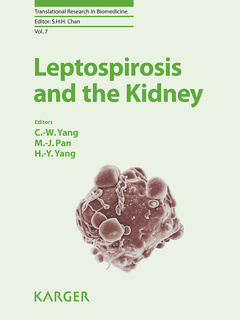Description
Leptospirosis and the Kidney
Translational Research in Biomedicine Series, Vol. 7
Language: English
Subjects for Leptospirosis and the Kidney:
Keywords
Publication date: 09-2019
106 p. · Hardback
106 p. · Hardback
Description
/li>
Leptospirosis is the most common zoonotic disease worldwide, involving at least 1 million patients annually. Kidney is the preferential colonization site where Leptospira accumulates during systemic infection, primarily in the interstitium and in renal tubule epithelial cells. In acute kidney injury (AKI), the main histological findings are acute tubulo-interstitial nephritis and acute tubular necrosis, characterized by hypokalemia and non-oliguria. The injury caused by leptospira outer membrane protein components involves innate immunity Toll-like receptor pathways and activation of complement and immune cascades in the kidney, together with extracellular matrix accumulation when the kidney infection progress to chronic kidney disease (CKD). Significantly, recent studies indicate that leptospira may induce CKD in humans either with AKI-CKD continuum or subclinical leptospira infection leading to CKD. Leptospirosis kidney disease thus represents a newly discovered and previously overlooked area requiring intensive medical and public health attention and investigation. In this book, leading experts in the field contribute their cutting-edge clinical and research experiences for the understanding of leptospirosis kidney disease. The outstanding feature of this publication is emphasizing kidney injury and disease induced by leptospirosis, an underestimated infection involving multiple organs. The book contributes information on current knowledge of leptospirosis kidney disease and a new perspective for future research.
© 2024 LAVOISIER S.A.S.
These books may interest you

Nutrition in Kidney Disease 189.89 €



